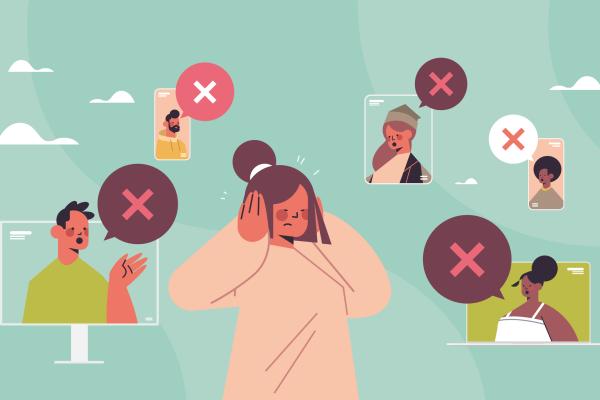It's a fact of life: whenever people get together to talk in a group, people are bound to monopolize the conversation ... or speak over one another ... or otherwise act in ways that are less than productive to your goals.
These behaviors don't make people "bad." (Heck, most of us have been guilty of these things at one time or another.) It's important to remember that people behave the way we do for many reasons; problematic behaviors often occur when people are struggling to cope with stress, change, fear or insecurities. But ultimately, these behaviors are unhelpful to everyone in the room — especially when they create conflict and tension.
Below are five common behaviors that you might come across while leading a conversation program — and how to address them to keep your discussion on track.
1. Hostility

During a book club discussion about Catcher in the Rye, Becky states that she didn’t like the book because the character of Holden was too whiny and entitled. As Becky starts to describe why she felt this way, Joe angrily interrupts her stating that she clearly didn’t read the book because if she did she would understand that it’s a great coming of age story about the dilemma of being between adolescence and adulthood.
Some people may direct their anger toward others. This may be done cynically, sarcastically, or argumentatively in response to statements made by others. In some instances, they may try to undermine the conversation. At times, this can be a defensive behavior, a way to gain a sense of control, or the result of someone feeling obligated to participate. How to address hostility:
- Identify the behavior (e.g., “That comment sounded sarcastic to me.”)
- Use empathy (e.g., “It sounds as though you feel angry about that,” or “It seems as though you have some strong feelings about that topic.”)
- Be honest about your role (e.g., “I feel responsible for making sure everyone is heard, but I also have to keep the meeting on track.”)
- Divert the conversation (e.g., “I’d like to talk with you about this later.”)
You do not have to allow people to be disruptive. Set clear expectations for meeting behavior with your ground rules at the start, and be consistent. If someone is disruptive, refer back to the ground rules as an agreement everyone made for how they would engage one another.
If the hostile person refuses to cooperate, take a break if needed and speak with the person privately. Explain to him/her that you want them to have an opportunity to participate but that their behavior is disruptive. Give examples and ask for their cooperation.
If they simply refuse or continue to be hostile to others despite your efforts, you may need to ask that person to leave or end the conversation. This decision will depend on the type of meeting, time remaining, and your comfort level with confronting the hostile person. You may wish to refer to library policies on hate speech when appropriate.
2. Domination
In a community conversation about funding public education, Bruce starts the conversation by talking about his idea to have businesses sponsor school activities. The facilitator thanks him for sharing and invites others to share. After Alma begins to speak about her concerns for burdening low-income families, Bruce jumps in again and speaks over her, stating that with his idea there wouldn’t be a burden on these families. He continues to speak over others, referring back to his idea and its value above all other ideas.
Individuals who constantly talk or interject when someone else is speaking may begin to dominate the conversation. Often this person feels what they have to say is more important than what anyone else could possibly contribute. The person may not be aware of the amount of time they have spoken during a meeting. It’s possible that they act this way because they do not feel valued, do not know how to express themselves, or are looking for attention.
Tools for preventing domination:
- Use a talking object. By setting the rule that whoever has the talking object is allowed to speak, you set the expectation that people will not speak out of turn. Refer back to that rule when someone violates it.
- Be explicit in your ground rules. Instead of stating “no one will dominate,” be more specific in your language, such as, “once you have spoken twice, wait for four others to contribute before weighing in again.”
How to address domination:
- When there is a pause, thank the person and invite someone else to speak.
- Interrupt if the person carries on. Be gentle, but firm. (e.g., “Bruce, I’m sorry to interrupt, but you have shared quite a lot with us tonight while others have not had a chance to speak. Would you be willing to allow a few others to share first?”)
- Review time limits and/or ground rules with the whole group.
- After the meeting, ask the person if there is anything you can do to support them. Let them know that you appreciate their participation, but want to make sure others are able to contribute equally. Ask them if there is any way you can help them with sharing space with others.
3. Experts
In a conversation about addressing community impacts from climate change, Angela states that all the community needs to do is stop eating meat in order to stop climate change. She quotes studies about the amount of water used to raise cattle and process meat, and shares figures on the impact that will have. Others in the group include a local rancher, who looks rather uncomfortable and has stopped contributing to the conversation.
Some participants may be experts on a topic. Others may just act as if they are experts about everything. These contributions can feel challenging because they can shut down other participants who don’t feel as knowledgeable. Sometimes this behavior can come about because someone is not feeling valued by the group, or they may have a personal agenda.
How to address an expert:
- Share your observation (e.g., “It seems you have a lot of information on this particular topic. Perhaps we could find another time to discuss this further.”)
- Unvite the contribution in another format (e.g., “It sounds like you have several ideas about this. Would you be willing to write up a brief summary for us?”)
- Refocus the conversation (e.g., “It sounds like you have a good historical perspective on this, but right now we need to focus on the topic at hand.”)
- Invite others to contribute (e.g., “It is clear you have a strong idea of what you think we should do. I’d like to see what others think should be done.”)
4. Fixers
In a community conversation following a panel discussion about drug abuse and the opioid epidemic, the facilitator asks people to start by sharing how the subject has impacted them and their families. Shelly starts by stating that the community needs to set up a rehabilitation center to give people a place to go for treatment nearby. While some seem receptive to this idea, many have not had a chance to respond to the question about their experiences. People start to respond directly to Shelly about her idea instead.
You may observe participants who just want to fix the problems—whether the problem is the topic being discussed or the problems other participants share from their own experience. These individuals may feel they are being helpful but can frustrate others who just want to be heard, and they can be disruptive when a collaborative solution is needed.
How to address a fixer:
- Acknowledge them and redirect (e.g., “It seems that you really want to help solve this issue. I’m sure others may have some ideas as well.”)
- Re-state the purpose of the meeting (e.g., “Today’s conversation is about hearing people’s experiences. Let’s give people the space they need to share.”)
- Point to the agenda (e.g., “I understand you have some ideas for resolving this, but we’re still working through identifying the issues.”)
How you address the fixer may depend upon the type of conversation you are having (whether you are seeking ideas or just sharing experiences) and the point in the conversation you find the group in. Use the ideas for addressing the fixer above in the appropriate context of your conversation.
5. Reserved people
In a board meeting, one of the members of the board has not spoken at all. You are more than halfway through the agenda when you realize this. They don’t appear to have anything to say or to be trying to break into the conversation.
Some individuals may appear to be uncomfortable participating or may be content just to listen. Depending on the purpose of the conversation, this may or may not be troublesome.
When you need the group to work together, having someone who does not participate can be frustrating. It may be that this person does not feel they have something to contribute, or they may be introverted and uncomfortable speaking without thinking first.
How you can address reserved people:
- Invite contributions: “Is there anyone who hasn’t had a chance to speak who would like to?”
- Speak to reserved people individually during a break to ask how you can support their participation.
- Consider reserved individuals in your planning. Offer options for participation aside from speaking in front of a large group. This may include breaking into one-on-one conversations for a time, allowing people to respond to prompts on paper, giving them the option to draw ideas, or collecting thoughts that can be shared with the group anonymously. These are all valid ways to contribute to a conversation and make the shy or introverted individuals feel welcomed and able to participate.
To learn more about facilitating virtual or in-person conversations, check out ALA's "Leading Conversations in Small and Rural Libraries" facilitation guide.



